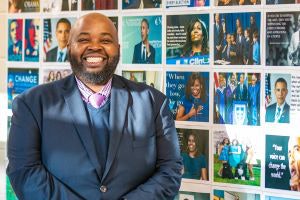Growing up in rural Virginia, Rodney Robinson only had one Black male teacher.
He served as not only an educator but as a “role model” and “confidante” outside of the classroom.
However, due to the lack of representation in the classroom, Robinson and other Black students at his school “ran” to historically Black colleges and universities (HBCUs) after graduation.
 Rodney Robinson
Rodney Robinson“We had to get that cultural relevancy that was missing throughout our entire K-12 experience,” said Robinson, senior advisor with Richmond Public Schools and 2019 National Teacher of the Year by the Council of Chief States Schools’ Officers.
His story is not uncommon.
Other educators shared similar sentiments, many of whom had not been exposed to even one Black male teacher, during Educational Testing Service’s (ETS) virtual seminar, “Building Black Male Educator Pipelines Through Effective Recruitment,” on Tuesday.
The three-part series aims to highlight the low representation of Black males within the teaching profession and provide recruitment strategies to strengthen the pipeline.
“Each stakeholder in the educator pipeline has work to do to support diverse classrooms,” said Dr. E. Wyatt Gordon, executive director of professional educator programs at ETS. “We are here today to highlight the issue, breathe life into solutions, connect with our colleagues and to seek out remedies and move the needle for diverse teachers and students alike.”
According to the National Center for Education Statistics (NCES), among the 3.7 million public school teachers, 79% are White while only 7% and 9% are Black and Latinx, respectively. As for leadership positions, there are 265 Black and 250 Latinx superintendents out of 13,700. Additionally, Black professionals make up only 10% of all K-12 principals.
At the same time, students of color consist of over 50% of the population within United States public schools, according to 2018 NCES data.
“They deserve teachers in their classrooms who motivate and encourage them, who do everything every single day to make sure that those youngsters get the equal opportunity and educational advancement that they deserve like all other children in this nation,” said Doris Smith-Ribner, Pennsylvania Commonwealth Court Judge Emeritus.
By third grade, Black students who’ve had at least one Black teacher remain 7% more likely to graduate high school and 13% more likely to enroll in college. After having two Black teachers, Black student college enrollment increases to 32%, according to Dr. Hal Smith, senior vice president for education, youth development and health at National Urban League.
L-Mani S. Viney, dean of students for Piscataway High School in New Jersey, said that, as a Black male educator, there is a “level of advocacy presented” in the classroom as well as a “spoken language” that is only understood by young Black men and Black women.
 Dr. Roy Jones
Dr. Roy Jones“There is a way in which we can see beyond the trauma and understand the traumas that they go through,” he added. “See the images that they may want to put on and go beyond that and get them on a proper trajectory.”
In order to diversify the teaching pipeline, the experiences of students at the K-12 level must be improved, Viney said.
Higher education institutions also hold responsibility in changing the system.
Robinson emphasized that predominantly White institutions must create spaces to accommodate Black students and understand their specific needs.
“Until we start having these true conversations of equity when it comes to K-12 and supporting our Black boys and higher education in supporting our Black men who want to go into education, we will always have trouble keeping and recruiting males of color,” he added.
On the other hand, Dr. Roy Jones, executive director for the College of Education’s Call Me MISTER® Program at Clemson University, recommended the use of Grow Your Own Teacher programs, where educators are recruited from the local community. This is accomplished by building partnerships among community colleges, four-year institutions, community organizations or school districts.
“Are we telling Black boys that [they] could be great teachers?” Robinson asked. “Are we actually creating pathways to education for them instead of creating pathways to other careers?”
The second part of the series, set to launch in May, will focus its conversation around supporting, developing and retaining Black educators.
“I leave today optimistic that if one day I am fortunate to have grandchildren, that they will tell me amazing stories about their teachers,” said Dr. Michael T. Nettles, senior vice president and Edmund W. Gordon Chair of Policy Evaluation and Research at ETS. “Some of whom will look like me.”
Sarah Wood can be reached at [email protected].





















